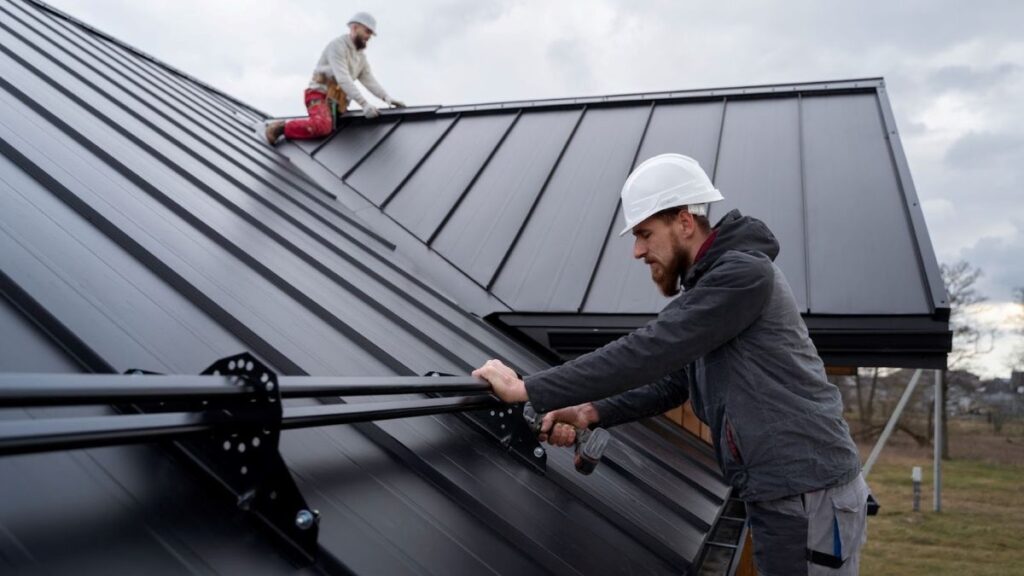Your home’s roof is its first and most important shield against the elements. It guards against harsh weather, contributes to your energy efficiency, and plays a major role in your property’s curb appeal. Yet, despite this vital role, roofing often goes unnoticed—until it fails.
A well-designed, professionally installed roof can last decades. But for that longevity and reliability to be achieved, it’s crucial to understand the materials, systems, and professionals involved in its construction. This guide provides a deep dive into modern roofing solutions for homes, offering valuable insight for anyone considering a new installation, a repair, or a full replacement.
The Role of a Roof in Home Protection and Value
A roof is more than just the surface you see from the curb. It’s a multi-layered system designed to manage water, regulate airflow, and insulate the home. At its core, the roof must achieve three essential goals:
- Weather protection: Keeping out rain, snow, wind, and UV rays.
- Structural support: Ensuring the home’s frame remains solid and aligned.
- Energy efficiency: Preventing unwanted heat transfer and moisture buildup.
Beyond performance, your roof is a key part of your home’s exterior design. The right materials and colors can complement your architecture and increase resale value.
Understanding Roofing Systems
Modern roofing systems are far more advanced than a layer of shingles nailed to wood. A standard roofing structure includes:
- Decking (base layer that supports the weight)
- Underlayment (waterproof or water-resistant barrier)
- Flashing (seals around edges and protrusions)
- Ventilation (exhausts heat and moisture from the attic)
- Shingles or surface covering (the visible outer material)
- Gutters and drainage systems (channel water safely away)
All of these components must work together to create a durable, weather-resistant barrier. Improper installation or poor integration can lead to costly failures even if the materials themselves are top quality.
Choosing the Right Roofing Material
There are many materials available for homeowners today. Your choice should be based on climate, budget, aesthetic preference, and expected lifespan.
a. Asphalt Shingles
- Most common material for residential use
- Affordable, versatile, and easy to install
- Lifespan: 20–30 years
b. Metal Roofing
- Increasingly popular for its longevity and durability
- Reflective properties improve energy efficiency
- Lifespan: 40–70 years
c. Clay and Concrete Tile
- Excellent for hot climates due to thermal resistance
- Heavy—requires additional support
- Lifespan: 50–100 years
d. Wood Shingles or Shakes
- Natural and beautiful, often used in historic or cottage-style homes
- Requires maintenance and is less fire-resistant
- Lifespan: 25–40 years
e. Slate
- Premium material with unmatched longevity
- Requires expert installation
- Lifespan: 75–150 years
Each material offers a different blend of durability, appearance, and maintenance needs. A professional assessment can help you find the perfect match for your home’s design and environmental conditions.
The Installation Process: What to Expect
A proper roofing installation follows a specific sequence designed for safety, durability, and quality. Here’s a general overview:
Step 1: Inspection & Estimate
A contractor examines the current roof for structural damage, rot, or existing leaks. Then, they provide a detailed quote with materials, timelines, and labor costs.
Step 2: Tear-Off or Overlay
Depending on your roof’s condition, the contractor will either remove the old roofing (tear-off) or apply new material over existing layers (overlay). Tear-offs are more expensive but typically yield longer-lasting results.
Step 3: Underlayment & Flashing
A waterproof or water-resistant underlayment is applied to the decking. Flashing is installed around chimneys, vents, valleys, and skylights to prevent leaks.
Step 4: Surface Material Application
The primary roofing material—whether shingle, tile, or metal—is applied with attention to detail and according to manufacturer specifications.
Step 5: Cleanup & Final Inspection
Debris is removed, the site is cleaned, and a final inspection is conducted to ensure compliance with safety and performance standards.
5. Signs Your Roof Needs Attention
Many homeowners wait until water starts dripping into their home before calling a roofer. But small issues caught early can prevent major expenses.
Warning signs include:
- Missing, curled, or cracked shingles
- Dark streaks or moss on the roof surface
- Shingle granules in gutters
- Sagging rooflines
- Water stains on ceilings or walls
- Drafts or hot spots in your attic
Even if your roof is relatively new, annual inspections are recommended—especially after severe weather events.
Maintenance for Long-Term Performance
A proactive approach to roof care can add years to its life and prevent sudden failure. Here’s what ongoing maintenance should look like:
- Clean leaves and debris from the roof and gutters regularly
- Check flashing and caulking for signs of wear
- Trim overhanging tree limbs to prevent damage
- Inspect attic insulation and ventilation
- Schedule professional roof inspections every 12–24 months
Small cracks, lifted edges, or buildup of debris might seem harmless but can lead to moisture damage, mold, or even structural compromise if ignored.
Roofing and Energy Efficiency
A lesser-known but vital aspect of residential roofing is its role in energy savings. The roof directly influences how well your home retains heat in winter and reflects it in summer.
Ways your roof affects efficiency:
- Reflective coatings reduce heat absorption
- Proper insulation in the attic minimizes energy loss
- Ventilation reduces moisture and temperature extremes
- Cool roofs use special materials to deflect sunlight and lower internal temps
Upgrading your roofing system can reduce your energy bills by 10–25% depending on your climate and home design.
Working With Professional Contractors
Choosing a qualified roofing professional is just as important as selecting the right materials. Poor workmanship can void warranties, shorten roof lifespan, and result in costly repairs.
Look for contractors who:
- Are licensed and insured
- Have solid online reviews and references
- Provide clear, itemized estimates
- Offer both manufacturer and labor warranties
- Have experience with your chosen roofing type
Professional contractors also stay up-to-date with building codes, permitting requirements, and modern installation techniques. You can expect accountability, transparency, and a clean, timely project when working with reputable specialists.
Warranties: What You Need to Know
Warranties vary based on materials and installers, but there are generally two types:
- Material Warranty: Issued by the manufacturer, covering defects in the roofing products (usually 20–50 years)
- Workmanship Warranty: Offered by the contractor to guarantee proper installation (ranges from 1–15 years)
Before starting a project, ask what’s covered, what’s excluded, and how to make a claim if needed. Get all warranty information in writing.
- Trends in Roofing Design and Innovation
Today’s residential roofing is more than function—it’s about form, efficiency, and smart integration.
Notable trends include:
- Architectural shingles: Dimensional styles that mimic wood or slate
- Solar shingles: Discreet energy-generating roofing options
- Synthetic materials: Lighter, more durable alternatives to wood or slate
- Green roofing: Living roofs that support vegetation and improve insulation
Advancements in materials and construction methods are giving homeowners more choices than ever—without sacrificing performance.
The Smart Choice for Home Protection
Roofing is one of the few home improvements that impacts virtually every aspect of daily life—from comfort and health to safety and style. Whether you’re upgrading for energy savings, planning a remodel, or recovering from a storm, making informed decisions will protect your investment.
When it’s time to take action, working with a trusted provider in residential roofing ensures you receive not only quality materials, but also professional service, thoughtful design, and long-lasting protection.
If you haven’t scheduled an inspection in the last year, or if you’ve noticed signs of wear, now is the time to act. A sound roof is a secure home—and the foundation for comfort and peace of mind for years to come.







